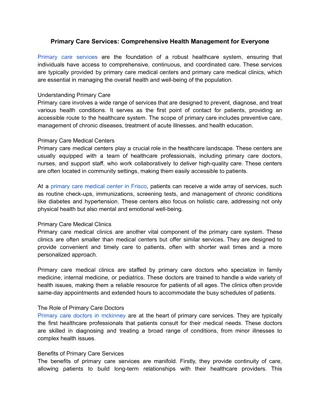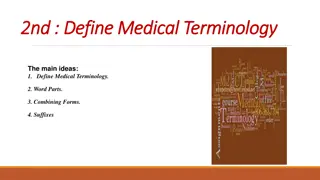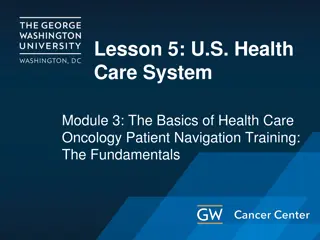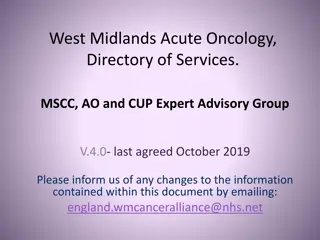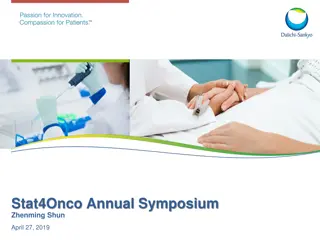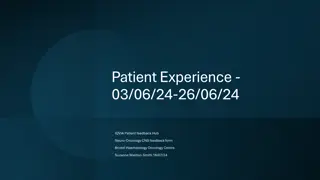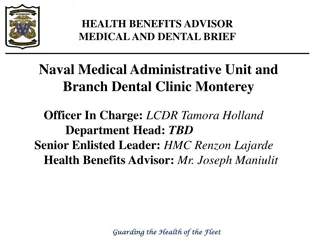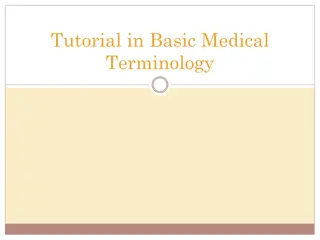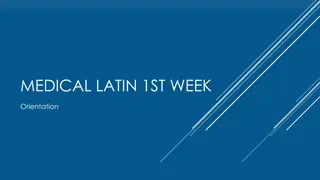Basics of Medical Terminology in Health Care Oncology
This module provides training on medical terminology basics for patient navigators in oncology. It covers defining terms using prefixes, root words, and suffixes, common oncology words, and available resources. Learn how to approach medical terminology effectively by understanding word roots and components. Explore word breakdowns, prefixes, and their meanings in healthcare contexts.
Download Presentation

Please find below an Image/Link to download the presentation.
The content on the website is provided AS IS for your information and personal use only. It may not be sold, licensed, or shared on other websites without obtaining consent from the author. Download presentation by click this link. If you encounter any issues during the download, it is possible that the publisher has removed the file from their server.
E N D
Presentation Transcript
Lesson 1: Medical Terminology Module 3: The Basics of Health Care Oncology Patient Navigator Training: The Fundamentals
Acknowledgements This work was supported by Cooperative Agreement #1U38DP004972-02 from the Centers for Disease Control and Prevention. Its contents are solely the responsibility of the authors and do not necessarily represent the official views of the Centers for Disease Control and Prevention. Portions of this lesson are adapted with permission from the Patient Navigator Training Collaborative of the Colorado School of Public Health (referenced as Source: PNTC).
Competency This lesson covers the following Core Competency for Patient Navigators: 2.1 Demonstrate basic knowledge of medical and cancer terminology
Learning Objectives Define basic medical terms using prefixes, root words and suffixes Describe common words used in oncology Identify resources on basic medical terms
How To Approach Medical Terminology Develop your skill set Find a resource that will help you understand Greek/Latin word roots Learn to break down words to smaller components Keep your own list of common words Onco tumor + - logy science or study of. Source (example): Siegel R, et al. CA Cancer J Clin. 2012 Source: Online Etymology Dictionary. 2014
Word Breakdown Prefix Root Suffix Helps to describe the location, direction, amount Location: near, towards, upon, within, around, Direction: away from, beneath, above, between, before, after Amount: lack of, without, excessive, difficult Helps to determine which part of the body it relates to Helps to describe what the word or problem relates to Source: Penguin Prof Pages. 2014
Prefixes PREFIX AN-, A- AB- AD- BI- DYS- ECTO- WHAT IT DESCRIBES without / lack of away from near / toward two / both difficult / painful outside EXAMPLE anemia = lack of red blood cells abnormal = away from the normal adrenal gland = gland near to the kidney bilateral Wilm's = tumor in both kidneys dysfunction = not working properly ectopic pregnancy = outside the uterine cavity endoscope = an instrument to look inside the body cavities or organs epidermis = the outer layer of skin hyperglycaemia = excessive blood sugar levels hypodermic = injection below the skin intercostal = between the ribs intravenous = into a vein parathyroid = beside the thyroid gland pericardium = membrane around the heart prenatal = before birth post surgical stage = stage after surgery submucosa = tissue below mucus membrane syndrome = group of symptoms occurring together Source: Online Etymology Dictionary. 2014 ENDO- inside upon excessive / above beneath / below between within / Inside beside, about, near around before after under / below together with EPI- HYPER- HYPO- INTER- INTRA- PARA- PERI- PRE- POST- SUB- SYN-
Prefixes Size Direction and location Macro (large) Micro (small) Megalo or Megaly (abnormally large) Hyper (fast, elevated, overproducing, energetic) Hypo (slow, low, under- producing, low energy Tachy (rapid) Brady (slow) Extra (outside, excess, beyond) Endo (within) Intra (within) Inter (between, together, during) Peri (about, around, surround) Trans (across, beyond, through) Source: Online Etymology Dictionary. 2014
Root Words ROOT BLAST- CARCINO- CARDIO- CYTO- DERMA- HISTIO- HEPATI- MALIGN- NEPHRO- NEURO- ONCO- OSTEO- PAED- WHAT IT DESCRIBES germ, immature cell cancer heart cell skin tissue liver bad kidney nerves mass bone/bony tissue child EXAMPLE blastoma = a cancer made of immature cells carcinogenic = cancer causing cardiotoxicity = toxicity to the heart cytotoxic = toxic to the cell dermatitis = inflammation of the skin histology = study of tissue hepatoblastoma = liver cancer harmful malignant = growing, spreading nephrotoxic = harmful to the kidneys neuroblast = an immature nerve cell tumor oncology = the study of cancer osteosarcoma = bone cancer pediatric oncology = study of childhood cancer sarcoma = tumor of bone, muscle, or connective tissue toxicology = study of poisons Source: Online Etymology Dictionary. 2014 SARCO- TOXO- tissue poison
Frequent Root Words Oste(o) Bone Myo Muscle Neuro Nerves Derm Skin Angi(o) Blood vessels Ven(o) or Phleb(o) Veins Cardio Heart Rhino Nose Neph Kidney Source: Online Etymology Dictionary. 2014
Frequent Root Words Cranio Skull Opthalmo or oculo Eye Oto Ear Thromb(o) Blood clot Hepato Liver Mamm(o) Breast Colo Large intestine Gastro Stomach Ileo Small intestine Thorac(o) Chest Pneumo or pleuro Lung Source: Online Etymology Dictionary. 2014
Suffix SUFFIX WHAT IT DESCRIBES EXAMPLE -AEMIA condition of blood leukemia = cancer of blood cells -ECTOMY excision / removal nephrectomy = excision of a kidney -ITIS inflammation hepatitis = inflammation of the liver -OLOGY study / science of cytology = the study of cells -OMA tumor retinoblastoma = tumor of the eye neuropathy = disease of the nervous system -PATHY disease -OSIS disease /condition necrosis = dying cells Source: Penguin Prof Pages. 2014
Other Common Roots and Suffixes Tests and Procedures Using ultrasonic waves Echo- Using electricity Electro- Removal of - ectomy Picture - gram Process of making an image - graph(y) Making a cut in - otomy Using an instrument for viewing - scopy Create an opening - stomy Source: Penguin Prof Pages. 2014
Resources National Cancer Institute s Dictionary of Cancer Terms American Cancer Society s Guide to Treatment Types University of Minnesota s WebAnatomy
Checkpoint Adenocarcinoma a) Adeno meaning adrenaline, -Carcino meaning heart describes a fast beating heart. b) Adeno meaning glands, -Carcino meaning cancer describes cancer in the glands. c) Adeno meaning glands, -Carcino meaning heart describes the heart glands Source: NCI Dictionary of Cancer Terms. 2015.
Checkpoint Biopsy a) Bi meaning living tissue, - opsy meaning removal b) Bi - meaning living tissue, -opsy meaning inspection c) Bi meaning living tissue , - opsy meaning insertion Source: NCI Dictionary of Cancer Terms. 2015
Checkpoint Dyspnea a) Dys- meaning distant pnea meaning urination describes trouble with urination b) Dys meaning normal pnea meaning respiration describes normal breathing c) Dys- meaning difficult pnea meaning breathing describes difficulty in breathing Source: NCI Dictionary of Cancer Terms. 2015
Conclusion Define basic medical term using prefixes, root words and suffixes Describe common words used in oncology Identify resources on basic medical terms
References Collins English Dictionary. (2015). http://dictionary.reference.com/. Dictionary.com Unabridged. (2015). http://dictionary.reference.com/. National Cancer Institute. (n.d.). Dictionary of cancer terms. http://www.cancer.gov/dictionary. Online Etymology Dictionary. (2015). http://dictionary.reference.com/. Penguin Prof Pages. [ThePenguinProf]. (2011). Medical Terminology [Video file]. https://www.youtube.com/watch?v=3fiEszFPRE8&feature=youtu.be. The American Heritage Science Dictionary. (2015). http://dictionary.reference.com/. The American Heritage Stedman s Medical Dictionary. (2015). http://dictionary.reference.com/.
Thank you! Follow us on Twitter: @GWCancer www.gwcancercenter.org Sign-up for the GW Cancer Center s Patient Navigation and Survivorship E-Newsletter: bit.ly/PNSurvEnews Sign-up for the GW Cancer Center s Cancer Control Technical Assistance E-Newsletter: bit.ly/TAPenews








